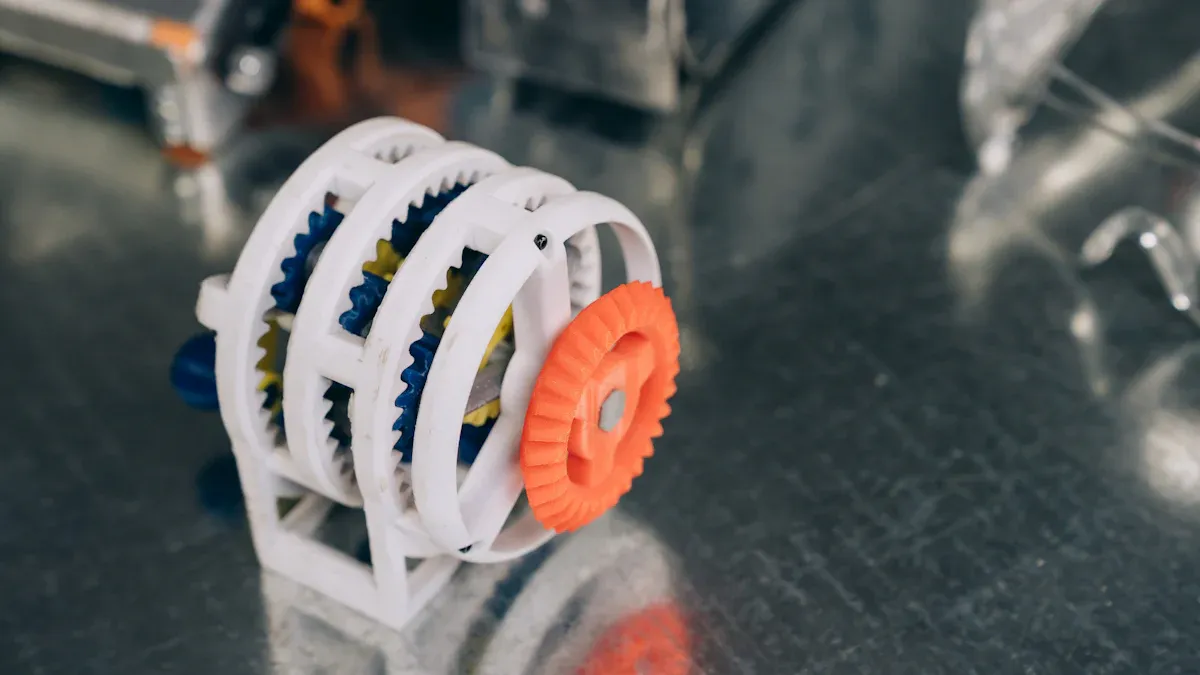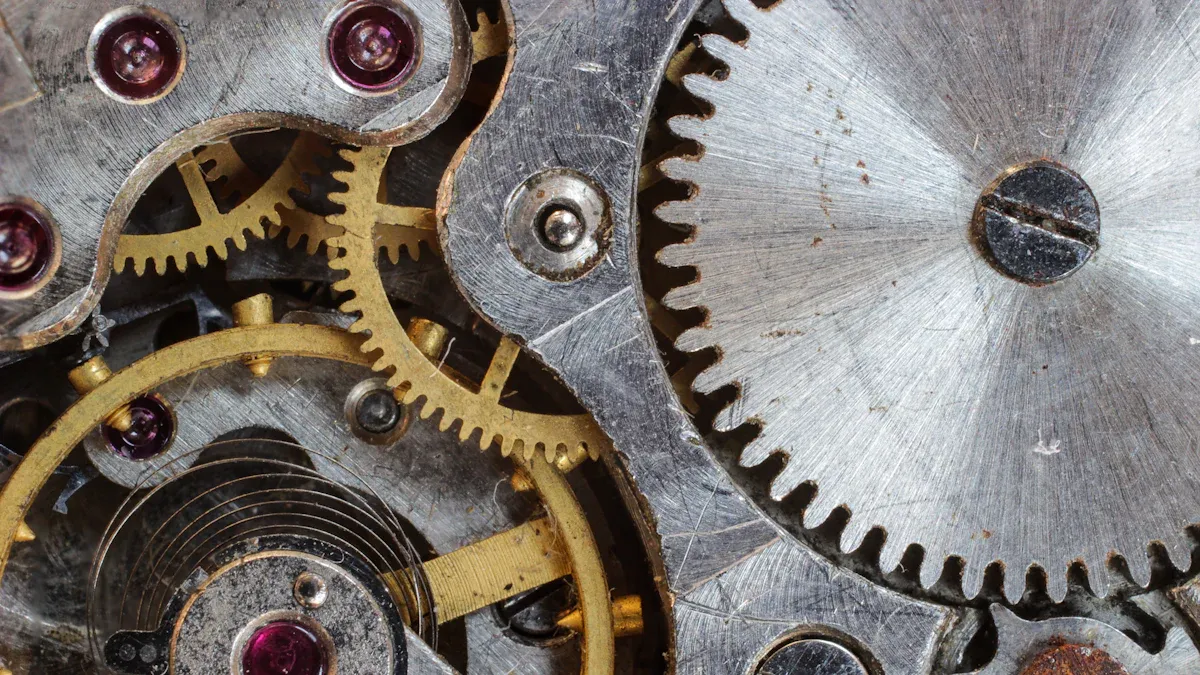
Choosing the right material for precision gears is critical for ensuring reliable performance, especially when considering POM vs. Nylon. Both high-performance engineering plastics offer unique advantages depending on your application needs. For instance, POM boasts a lower coefficient of friction (~0.25), making it ideal for precision parts requiring smooth operation. Nylon, on the other hand, excels in temperature resistance, handling up to 120°C in dry conditions. Factors like stiffness, tensile strength, and dimensional stability also play a vital role in determining which material, POM vs. Nylon, suits your precision parts. By understanding these differences, you can make informed decisions for your engineering applications.

When comparing the strength and stiffness of POM and nylon, you’ll notice distinct differences that impact their performance in precision parts. Nylon offers higher tensile strength, making it better suited for applications requiring resistance to pulling forces. POM, while slightly less strong, provides excellent stiffness, ensuring dimensional stability in gears. The table below highlights key mechanical properties of these materials:
| Property | Nylon 6/6 | Acetal (POM) |
|---|---|---|
| Tensile Strength | 12,000 psi | 9,800 psi |
| Flexural Modulus | 450,000 psi | 400,000 psi |
| Compressive Strength | 15,000 psi | 15,000 psi |
Nylon’s higher tensile strength makes it ideal for gears exposed to high stress. However, POM’s stiffness ensures it maintains its shape under load, which is crucial for precision applications. You should consider these properties based on the specific demands of your gear design.
Wear resistance plays a critical role in determining how long your gears will last. POM excels in this area due to its low friction and high dimensional stability. This makes it a top choice for precision parts that require smooth operation over time. Nylon, while durable, is more prone to moisture absorption, which can degrade its mechanical properties and reduce its lifespan. Here are some key points to consider:
If your application involves exposure to moisture or oils, POM will likely perform better due to its resistance to environmental degradation.
The load-bearing capacity of plastic gears depends on material properties and design factors. Both POM and nylon have lower load-bearing capacities compared to metal gears, but they can still handle significant loads when designed correctly. Here are some insights:
For applications requiring high load-bearing capacity, you should carefully evaluate the gear design and material choice. While nylon offers higher tensile strength, POM’s stiffness and dimensional stability make it a reliable option for precision parts under moderate loads.
When it comes to heat resistance, nylon and POM exhibit distinct characteristics that influence their performance in precision gears. Nylon has a higher melting point, ranging from 220°C to 265°C, compared to POM's melting point of 175°C. This makes nylon more suitable for applications requiring resistance to extreme heat. However, POM demonstrates better thermal stability under continuous heat exposure, maintaining its mechanical properties effectively.
| Material | Melting Point (°C) | Thermal Degradation Temperature (°C) |
|---|---|---|
| Nylon | 220 - 265 | > 150 |
| POM | 175 | More resistant to thermal degradation under continuous heat exposure |
If your application involves prolonged exposure to moderate heat, POM's stability ensures reliable performance. On the other hand, nylon's higher melting point makes it a better choice for short-term exposure to extreme temperatures.
In high-temperature environments, nylon and POM perform differently. Nylon can withstand temperatures up to 150°C for extended periods, maintaining its rigidity and strength. However, it struggles in hot water or steam, where it tends to degrade. POM, in contrast, retains its strength and dimensional stability even in such conditions, making it a more versatile option.
| Material | Performance at Elevated Temperatures |
|---|---|
| Nylon | Limited use in high temperature environments due to lower melting point |
| POM | Maintains mechanical properties up to 175°C, retains dimensional stability and strength |
| Material | Performance in Hot Water/Steam |
|---|---|
| Nylon | Degrades at high temperatures |
| POM | Retains strength and stability |
For dry, high-temperature applications, POM-H is particularly advantageous due to its superior dimensional stability and lower coefficient of linear thermal expansion. If your gears operate in environments with fluctuating temperatures, POM offers consistent performance. Nylon, while strong, may not provide the same level of reliability in such conditions.
When selecting materials for precision gears, their ability to resist chemicals and oils is crucial. Both nylon and pom exhibit excellent chemical resistance, but their performance varies depending on the application. Nylon demonstrates high resistance to oils, fuels, solvents, and alkalis, making it a reliable choice for automotive and chemical processing industries. Pom, on the other hand, excels in resisting organic solvents, fuels, and alkalines, which makes it ideal for precision parts in mechanical and automotive applications.
| Material | Chemical Resistance | Applications |
|---|---|---|
| POM | Resistant to organic solvents, fuels, and alkalines | Ideal for precision parts in automotive and mechanical industries |
| Nylon | Highly resistant to oils, fuels, solvents, and alkalis | Suitable for automotive, chemical processing, and electronics industries |
If your gears operate in environments with frequent exposure to oils or industrial chemicals, both materials offer strong performance. However, you should evaluate the specific chemicals involved to determine which material aligns better with your needs.
Moisture absorption significantly impacts the dimensional stability of precision gears. Nylon absorbs more moisture compared to pom, which can lead to dimensional changes in humid environments. This property makes pom a better choice for applications requiring consistent performance in wet conditions. Nylon, while strong, may experience swelling or warping when exposed to high humidity.
| Material | Moisture Absorption Rate | Dimensional Stability Impact |
|---|---|---|
| Nylon 6/6 | 7% at saturation | Significant dimensional changes in humid environments |
| Acetal | 0.9% | Stable in wet environments, minimal dimensional changes |
If your application involves exposure to water or high humidity, pom offers superior dimensional stability. Nylon may still perform well in dry conditions but requires careful consideration in environments with fluctuating moisture levels.
When it comes to plastic machining, Delrin stands out as a top choice. Its excellent machinability allows you to achieve smooth finishes and tight tolerances with minimal effort. Delrin’s low moisture absorption ensures consistent performance during machining, making it ideal for precision parts like gears. You’ll find that Delrin machines faster and more efficiently compared to nylon, reducing production time and costs.
Nylon, while machinable, requires more attention during the process. Its higher flexibility can lead to challenges in maintaining dimensional accuracy. Additionally, nylon’s tendency to absorb moisture may affect its stability during machining. This makes it less predictable than Delrin in achieving precise results. However, nylon’s impact resistance and flexibility make it suitable for applications where these properties are critical.
| Material | Machinability Characteristics | Moisture Absorption | Flexibility |
|---|---|---|---|
| Delrin | Easier to machine, higher precision | Low | Low |
| Nylon | Machinable but requires more attention | High | High |
If you prioritize ease of machining and dimensional stability, Delrin offers a clear advantage over nylon.
Precision machining is essential for manufacturing gears with tight tolerances. Delrin excels in this area due to its high dimensional stability and low thermal expansion. These properties allow you to produce gears that maintain their shape and function under varying conditions. Delrin’s superior machinability also ensures that you can achieve intricate designs with consistent accuracy.
Nylon, on the other hand, presents challenges in maintaining tight tolerances. Its higher moisture absorption rate can lead to dimensional changes, especially in humid environments. While nylon offers excellent wear resistance, its moderate machinability and stability make it less reliable for precision gear manufacturing.
| Material Properties | Delrin | Nylon |
|---|---|---|
| Dimensional Stability | Excellent | Moderate |
| Tight Tolerances | Easy to achieve | Difficult to maintain |
| Wear Resistance | Good | Excellent |
For gears requiring tight tolerances and consistent performance, Delrin proves to be the better choice. Its machinability and stability make it a reliable material for precision parts.
When comparing the costs of POM and nylon, you’ll notice significant differences. POM is generally more expensive than nylon, which can make it less appealing for cost-sensitive industries. Its higher price stems from its superior mechanical properties, such as stiffness and low friction, which are essential for precision gears. However, nylon offers a more budget-friendly option while still providing excellent strength and durability.
If you’re working on a project with tight budget constraints, nylon might be the better choice. It delivers reliable performance at a lower cost. On the other hand, POM’s higher price tag can be justified in applications where its unique properties, like dimensional stability and wear resistance, are critical.
While nylon may have a lower upfront cost, POM often provides better long-term value. Its low wear rate ensures that gears made from POM last longer, reducing the need for frequent replacements. For example, the wear rate for a POM pin and PK disk is 2.9 mm³/Nm, while a PK pin and POM disk show an even lower wear rate of 0.2 mm³/Nm. This durability makes POM a cost-effective choice over time, especially in demanding environments.
Nylon, although durable, absorbs moisture, which can lead to dimensional changes and increased maintenance costs. In contrast, POM’s resistance to moisture and chemicals ensures consistent performance with minimal upkeep. Additionally, POM’s machinability reduces production time and costs. Aliphatic polyketone resins, for instance, can cut injection molding cycle times by 15-30% compared to POM or nylon, further enhancing efficiency.
If you prioritize long-term reliability and reduced maintenance, POM stands out as the better investment. However, nylon remains a strong contender for applications where initial costs are a primary concern.

POM, also known as Delrin or acetal, is an excellent choice for precision gears in applications requiring high dimensional stability and low friction. Its unique properties make it ideal for environments where consistent performance and durability are critical. You should consider POM for the following scenarios:
| Study | Focus | Findings |
|---|---|---|
| Hoskins et al. | Acoustic performance of polymer gears | POM gears exhibited superior noise reduction under various conditions. |
| Polanec et al. | Noise of coated POM gears | Uncoated POM gears had the lowest sound pressure levels. |
| Trobentar et al. | Acoustic behavior of different tooth profiles | S-gears made from POM showed better contact conditions and lower noise. |
If your application demands quiet, reliable, and high-precision performance, POM gears are a top contender. Their ability to maintain performance under challenging conditions ensures long-term value and minimal maintenance.
Nylon stands out as a versatile material for precision gears, particularly in applications requiring strength, toughness, and thermal stability. Its impressive mechanical properties make it a popular choice across various industries. You should choose nylon for the following applications:
| Key Factor | Description |
|---|---|
| Mechanical Strength | High strength-to-weight ratio for substantial mechanical stress. |
| Toughness | Absorbs energy before fracturing, ideal for impact-resistant applications. |
| Wear Resistance | Natural lubricity reduces friction, lowering wear in mechanical systems. |
| Thermal Stability | Retains strength in high-temperature environments. |
| Chemical Resistance | Resists oils, greases, and solvents, suitable for chemical exposure. |
Nylon gears also perform well in high-stress applications due to their wear resistance and natural lubricity. These properties reduce friction, extending the lifespan of the gears. If your application involves heavy loads, high temperatures, or exposure to chemicals, nylon gears provide a cost-effective and durable solution.
Choosing between POM and Nylon for precision gears depends on your specific needs. POM offers higher stiffness, better machinability, and excellent moisture resistance, making it ideal for precision applications. Nylon, with its superior wear resistance and cost-effectiveness, excels in high-stress or impact-prone environments.
| Property | POM | Nylon |
|---|---|---|
| Stiffness | Higher rigidity | Lower rigidity |
| Wear Resistance | Moderate | Superior |
| Moisture Resistance | Excellent | Absorbs moisture |
| Cost | Higher | More affordable |
For high-precision, low-maintenance gears, POM is the better choice. If budget and wear resistance are priorities, Nylon provides a reliable alternative.
POM is better for gears in moist environments. Its low moisture absorption (0.9%) ensures dimensional stability. Nylon absorbs more moisture (up to 7%), which can cause swelling or warping. Choose POM for consistent performance in wet or humid conditions.
Tip: Use POM for outdoor or marine applications where moisture exposure is unavoidable.
Yes, nylon performs well in high-impact applications. Its toughness allows it to absorb energy before breaking. This makes it ideal for gears in heavy-duty machinery or conveyor systems where durability is critical.
Note: Nylon’s impact resistance makes it a reliable choice for industrial environments.
Yes, POM is easier to machine. Its stiffness and low moisture absorption ensure precise results with minimal effort. Nylon, while machinable, requires more attention due to its flexibility and higher moisture absorption, which can affect dimensional accuracy.
Tip: Choose POM for tight tolerances and intricate gear designs.
POM offers better long-term value. Its durability and low wear rate reduce maintenance costs. Nylon has a lower upfront cost but may require more frequent replacements due to moisture absorption and dimensional changes.
Advice: Consider POM for applications where reliability and minimal upkeep are priorities.
Evaluate your application’s needs. Use POM for precision, moisture resistance, and low friction. Choose nylon for high-impact resistance, thermal stability, and cost-sensitive projects. Match the material’s properties to your specific requirements for optimal performance.
Reminder: Always test materials under actual operating conditions before finalizing your choice.